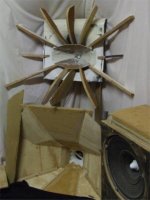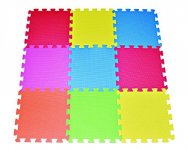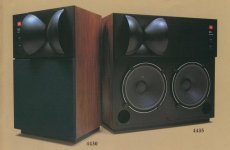In theory it should be able to hold out to 500Hz even if only just. At 500Hz axial reflection can more or less be compensated for, but wall reflections can be troublesome so I think it's a matter of how you plan to position it.
I've heard of one guy that used it to 300Hz and reported good results but I don't recall the details. The seos was developed empirically so I wonder how the transition from round was handled. The throat behaviour is in some respects more important than what happens later, depending on what problems actually arise but these can be analysed beforehand. My humble opinion is that the seos would be perfect for an econowave project.
Below is an old photo of my elliptical waveguide during construction, which I used for several months. It was built into the old round waveguide (the white square section) which was around 60cm across. I then went back to round and extended it to 80cm where it reaches 180 degrees. 500Hz performance is better at this dimension although the old (60cm) one could do 500Hz with some tweaking. At higher frequencies the ceiling reflection is a few dB higher but a ceiling absorber does more for that than the shape of the waveguide can.
I've heard of one guy that used it to 300Hz and reported good results but I don't recall the details. The seos was developed empirically so I wonder how the transition from round was handled. The throat behaviour is in some respects more important than what happens later, depending on what problems actually arise but these can be analysed beforehand. My humble opinion is that the seos would be perfect for an econowave project.
Below is an old photo of my elliptical waveguide during construction, which I used for several months. It was built into the old round waveguide (the white square section) which was around 60cm across. I then went back to round and extended it to 80cm where it reaches 180 degrees. 500Hz performance is better at this dimension although the old (60cm) one could do 500Hz with some tweaking. At higher frequencies the ceiling reflection is a few dB higher but a ceiling absorber does more for that than the shape of the waveguide can.
Attachments
I just put in one as a mono speaker along with an 18sound 15mb700 in my pottery studio.
I have been assuming you'll stay mono. Is that the case?
Is the space yours permanently - can you make changes / do epic installs like AllenB?
Can you eq easily?
If you go stereo, there's a possibility that you can simply set your current horns up with exaggerated toe-in, so you're always off-axis, eq to suit, and thereby get decent coverage.
If you stay mono, there's a chance that the normal rules for stereo ("a minimal compromise system"), such as reducing ceiling reflections might not be a good thing for you. Personal taste may rule, but you might find that a bit of reflected sound could be a good thing, make mono sound 'fuller'. Before you spend anything, you could experiment with increasing the % of diffuse sound in your current rig, and see if that could be to your taste.
The cheap PH316 horn I linked is something I'd normally avoid (I don't want a diffraction slot and extremely wide coverage angles), but these LoFi features might actually be good for a mono system.
Unfortunately when I am working in my studio I am rarely standing in front of them. They sound quite rolled off on top when off axis.
$300 [...] is quite a bit more than I would like to spend.
I would suggest Fostex T500AMKII or Aurum Cantus G1
A $1000 driver and a big (beamy) ribbon?
Hollowboy, the space is mine. The main issues I have are limited space, I can use all the space I want in that one corner, but my studio is pretty small and I have floor to ceiling shelving units in most of the rest of the studio. The other issue is a lack of time/energy. Working and having a two year old doesn't leave a lot of extra time or energy. I feel like it's not really in the DIY spirit, so I hate to admit to it, but I'm kind of hoping to avoid too much experimentation. Certainly I'll spend an evening taking measurements and setting everything up on the minidsp. Probably tinker around with the settings on the minidsp over time. I'm just hoping to find something that I can feel confident that I can make work. Maybe in a couple years my life will settle down and I can do more experimentation. It would be fun to build a large midbass horn for the corner.
Could you explain though why a diffraction slot might work in a mono system. I can't see why the same rules that apply to stereo hifi, wouldn't also apply to mono.
Thanks for all your thoughts and suggestions. I'll see if I can't find time to put the little 4" full range driver in the studio to try out a more diffused sound.
Could you explain though why a diffraction slot might work in a mono system. I can't see why the same rules that apply to stereo hifi, wouldn't also apply to mono.
Thanks for all your thoughts and suggestions. I'll see if I can't find time to put the little 4" full range driver in the studio to try out a more diffused sound.
Tight corner mounting puts constraints on a tweeter as the walls can double up on edge diffraction, so it should be self sufficient, but it can also be shrouded with absorption. A quartered single radial waveguide with the driver sunk behind the actual room corner is a good room match, but the throat transition becomes tricky.
The Seos-24 seems a good compromise. It has near the right profile in a ready package. You can fit it into the corner and line the walls as necessary. You can make extensions if required, and pad the ceiling if you will mount it high as you have currently.
The Seos-24 seems a good compromise. It has near the right profile in a ready package. You can fit it into the corner and line the walls as necessary. You can make extensions if required, and pad the ceiling if you will mount it high as you have currently.
😉It would be fun to build a large midbass horn for the corner.
Could you explain though why a diffraction slot might work in a mono system. I can't see why the same rules that apply to stereo hifi, wouldn't also apply to mono.
With stereo horns, pattern control & reducing reflections off walls = clarity & good imaging.
Since you don't have stereo and are not listening in the sweet spot, this may not be a thing to aim for.
For mono, some people prefer a 'wide' or diffuse sound source.
Thanks for all your thoughts and suggestions. I'll see if I can't find time to put the little 4" full range driver in the studio to try out a more diffused sound.
You could try just sticking the TB into a cardboard baffle, and popping it onto the bass enclosure, tilted back ~45 degrees to reflect off the roof. If you eq that ~flat, and hate the result, at least you'll know what you don't like.
There was once a commercial design kinda like this:
Wharfedale SFB/3 – Inner Magazine
The Seos-24 seems a good compromise. It has near the right profile in a ready package. You can fit it into the corner and line the walls as necessary. You can make extensions if required, and pad the ceiling if you will mount it high as you have currently.
What do you think is the best (time efficient) way to make extensions? Can they be pretty lightweight?
I've previously extended horns with timber and (lots of) gap filler glue, but I now think that's overkill / too heavy / too slow.
I haven't seen any polar plots of the seos-24
I put: seos 24 axial
Into a google image search
SEOS 24/Radian 951BePb + cardioid boxes - AVS Forum | Home Theater Discussions And Reviews
Yes, to a point. I have tested profiles using floor mats (especially at the mouth) because they are easy to shape and are fairly well damped. That said, some parts of the horn need to be solid, eg. mid/mid-bass horn rear chambers and throats out of seasoned hardwood. The seos would require more of a lip at the middle of the top and bottom than at the corners.What do you think is the best (time efficient) way to make extensions? Can they be pretty lightweight?
The problem with an extension is that it is not mechanically terminated and can ring at the edges. I have made roundovers using floor mats with thin fibreboard backing, or a piece of wood and wall spackle (polyfilla or plaster) to build up the curve. When a mounting surface exists but the curve is not yet at 90 degrees, I have bordered it with halved cardboard tubing.
Attachments
Alright, so the Seos-24 can only be bought in pairs 🙁. So, I don't seem to be able to find any commercial horns that offer something around 90 degree horizontal directivity, and loads low enough to crossover 600-700 hz. Am I missing anything? Maybe I do have to build another horn? Hollowboy I haven't forgotten your suggestion of a more diffuse sound, but I would also like to try a horn that can cover the whole room.
It'll be a while before I can get to them, but assuming there aren't any commercial horns that fit the bill, any suggestions/designs that I should looks at for diy horns.
I enjoy woodworking and like the look of these: Wood Horn. I'll do more research, but any input is welcome.
Thanks
It'll be a while before I can get to them, but assuming there aren't any commercial horns that fit the bill, any suggestions/designs that I should looks at for diy horns.
I enjoy woodworking and like the look of these: Wood Horn. I'll do more research, but any input is welcome.
Thanks
Vintage prosound CD diffraction horns such as Altec Mantaray load to 500 Hz, 90x40 nominal with better off axis response than expo, etc., including the 290H linked to and available as singles, though for best results will require an Altec/GPA 1" exit or if you want a more robust lower mids, then the larger 1.4" exit Mantaray, driver. JBL has similar 1", 2". These all require CD horn EQ to be flat all the way up.
GM
GM
Wow, the MantaRay 94B looks nice. They are available in 1.4" throat, which is what my Radian is.... why do you suggest altec/GPA driver? Eq is no problem.
Thanks!
Thanks!
I like Altec 500Hz horn, especially when mono. I don't think driver makes a huge difference with this horn, because horn itself has so much coloration by itself (in a good way, at least for me).
PS: sorry you guys were talking about newer Mantaray ones...
PS: sorry you guys were talking about newer Mantaray ones...
Last edited:
why do you suggest altec/GPA driver?
You're welcome!
Not familiar with the Radian, but the Altec drivers have a small conical horn built in that handles all the HF above ~ 7 kHz plus of course adds a little more total pathlength to help bolster up the horn's low end. Never tried other brands on any Altec horn, just the other way around.
GM
The JBL 2360 looks very similar to the Altec Mantaray 94. The JBL looks to be selling for about half the price though. Any thoughts on this horn?
The JBL is obviously for a 2" driver, but seems easy enough to make an adapter.
The JBL is obviously for a 2" driver, but seems easy enough to make an adapter.
The 2360 looks like the horns in the 4430. There is anecdodal evidence about.
Here is a photo of the 2360... Doesn't seem like the same horn as what's in the 4430.

The 2360 looks like the horns in the 4430.
Those are the 2404H, AKA 'butt or baby cheeks'.
GM
Last edited:
- Status
- Not open for further replies.
- Home
- Loudspeakers
- Multi-Way
- Looking for advice on adding a super tweeter to high efficiency mono speaker


